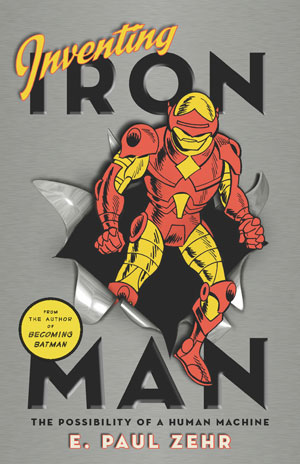
Inventing Iron Man is a kind of sequel to my earlier book Becoming Batman. That book was about asking how far can our biology take us toward the performance of the ultimately-trained Batman. With Inventing Iron Man the focus is on amplifying human ability with technology and the very question of how we interface with all our technology in the first place.
We have some pretty clunky interfaces (I am using one right now—it’s called a “keyboard”) when we use technology. If the Iron Man suit of armor existed we would never be able to control it with the conventional ways we use technology. Instead I suggest that the Iron Man suit would need to be directly connected to the brain and spinal cord of the user. It would have to be the most complex “brain machine interface” ever developed.
I illustrate this concept using ideas about how the nervous system works, and how things can adapt and change as a result of changes in activity. There really are fewer bigger changes in activity than riding around in an articulated, instrumented, and motorized suit of high-tech armor connected directly to your mind.
Using the Iron Man suit (if it existed) would require a technological interface bridging the gap between our nervous systems and devices like computers and robots. Let’s say that was possible…what happens then?
A lot of really bizarre things, actually. In Inventing Iron Man I give the example of plasticity in brain maps for the body muscles and skin areas. It is well known that after traumatic injuries like limb amputations other brain regions can take up the function of areas not in use because the body part is missing. This “remapping” is a really extreme example of neural plasticity—the reshaping of nervous system connections due to changes in activity.
This brings up the idea of what would happen when using a device like the Iron Man armor.
But there is a huge difference between thinking about how the brain remaps when something is lost and what happens to an intact nervous system. Someone using the armor hasn’t had an amputation and there isn’t anything missing. There is no brain territory to remap. So where does the armor go? I ask in one section “Is there space in Shellhead’s brain to store a skin of iron?” I phrase it as a funny question but the truth is, we don’t know. This is not a natural event, interfacing with machines and computers. We have no clear understanding of the long term effects of such interfacing.
This last bit is important if we take this line of thinking to its eventual conclusion—long term integration of computers, machines, and human minds. What would it do to the biological human connected to the technology? Where does human end and machine begin? What does it mean for being human, not just for human beings?
My main motivation behind writing the book was my continued passion for the popularization of science. I had some success using Batman as a popular culture icon for illustrating human biology. A lot of Becoming Batman helped satisfy the kinesiology part of my personality. Now I wanted to more specifically address my inner (and outer) neuroscientist!
I think many of the issues raised in Inventing Iron Man are important because they can help people understand how their brains work and why they work that way. And the vast mysteries that remain about how their bodies work. We all use technology routinely and we are rapidly converging on a point where we have to have a fundamental change in how we connect to the tech. Inventing Iron Man provides some answers and also raises some probing questions related to all these.
I think I would like your browsing reader to come across “Chapter 4. Multitasking and the Metal Man: How Much Can Iron Man’s Mind Manage?” This chapter is important because I address the main reason why you couldn’t wear a suit of armor like it was clothing. This sets up the need for it to be directly connected to the brain and spinal cord.
I frame this in the context of attention and how much—and how little—we have of this resource in different scenarios. This allows me to address some “simpler questions”, like why you shouldn’t use a cell phone while driving, and why pilots are so much better at multi-tasking. All of this is meant to both provide readers tangible points of reference to their own lives but also set up how complicated it really would be to use a brain-machine interface like the Iron Man suit of armor.
In many ways I really like this part of the book. It gets at the thing we all are doing so much—multi-tasking. We do this routinely and some of us take it to extraordinary lengths. And very dangerous ones like texting while driving, an activity that has caused too many deaths already. It also sets up a point I come back to later in the book about how brain machine interface can allow us to use technology to amplify biology. But if the thing we want to amplify isn’t working well, we just get something louder that works poorly on a grand scale! Garbage in, garbage out.
We need really good inputs in, and better outputs on the other side if we really will use brain machine interface. This means training is needed to create a finally tuned nervous system. And is a kind of nod to some of the themes in Becoming Batman. Bottom line is: we cannot escape our biological functions!
There are two main take home messages from Inventing Iron Man. I truly hope readers gain additional insight into the amazing ability for adapting and changing that the nervous system has. If you expose yourself to the right training stresses, you can adapt and tune yourself in marvelously complex and useful ways—even if not necessarily to control and robotic suit of armor with your mind! Another message is we should start to think about how to regulate our interface with technology now—before it really is feasible to do all of what I explore in Inventing Iron Man. There are big ethical (how will we use our enhanced abilities?) and safety (how does it change our biology?) issues here. Let’s try and address some of them in advance.
I have always been fascinated by brain machine interface and have mused about how far such interfaces can go. Inventing Iron Man represents my musings using a tangible pop culture icon. I like to think of this concept from the perspective of rehabilitation and how to improve and restore function. With this in mind, this kind of brain machine interface could be amazingly useful. Or amazingly dangerous. Or both.


E. Paul Zehr, PhD, is professor of neuroscience and kinesiology and director of the Centre for Biomedical Research at the University of Victoria. He is head of the Rehabilitation Neuroscience Laboratory with a research program focused on the neural control of movement and recovery of walking after stroke and spinal cord injury. He has a tremendous passion for the popularization of science and is involved in numerous outreach activities. His recent pop-sci books include Becoming Batman (2008) and Inventing Iron Man, both featured on Rorotoko.